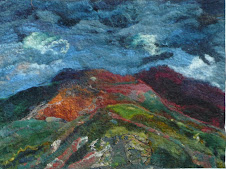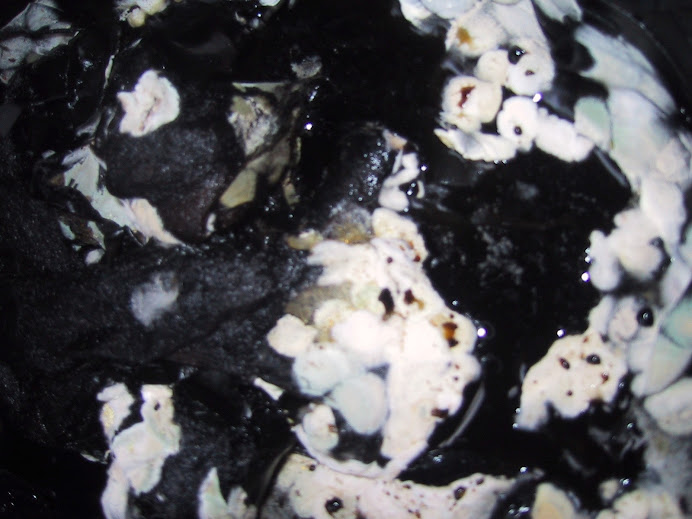Last night DH said with a huge sigh of relief. " Good! We can have a lie in tomorrow" This is because over the last few days we have had a textile group from Iceland visiting the dye garden and having a two hour workshop in the summer house and then two days later the BBC came to film the dye garden and what the director insisted on calling the " Dye Lady" for a Children's science programme called Nina and the Neurones. Hence DH's sigh of relief as it is he who rushes around mowing the lawn and setting up tables as well as removing dog particularly from the filming day (Because of unwanted woofing) while I work hard but get all the glory. I was too busy to take many photos but I have put one up of the washing line. Everything on this line was dyed using either plants in the garden or if not quite that by plant material that I also grow. (Except I realised belatedly the red on the extreme left had some cochineal in). This was in response to the BBC wanting a rainbow of colours on the line and was filmed a lot so it was worth the work. The yellows are Rhubarb root,Rheum spp, Gensita tinctoria and Tansy Tanacetum vulgare . The greens are Genista tinctoria and woad Isatis tinctoria. The blues are either woad Isatis tinctoria or Persicaria tinctoria (which also dyed the blue silks) . The mucky greens are a patchy pale indigo overdyed in rhubarb root. The really dark almost black fibre is somewhat surprisingly alkanet which I left on too high a heat so it boiled.( This is following extraction of the dye in alkanet by acetone) . The fabrics are silks dyed as solar dyed bundles .
Well I am here typing, because while DH is snoozing peacefully down stairs with dog, I am upstairs in my office having -and this is sod's law- woken up early! So I thought I would share with you my experiments with hopi red dye plant. Amaranthus .whatsit I have been told by a friendly comment that this is A. cruentus x A. powellii,which is just as well as every time I ask Enys she looks vague!
Enys tried to grow this two years ago, The seeds did not germinate so she threw the compost onto the greenhouse floor in disgust. The following year she noticed she had lots of little red plants growing on the green house floor. So she planted loads in my garden and in her own and in the green house.
When it came to dye with them I could find out very little. None of my dye books -even the one Enys bought back from the USA on native North American Dye Plants contains any information beyond the fact that the Hopi Indians used it for dyeing corn in ceremonies. A quick search on Google was not much help either resulting only in that the Aztecs also used it in some ceremonies around blood.
So I picked a large handful of leaves and flowers chopped them up covered with water and added some pre-mordanted silk and teeswater fleece and heated in a slow cooker. The teeswater went orange and the silk pinks as you can see but the pink washed out. I added some more fibres to the dye bath and everything went a deep vivid pink. About an hour of heating it all went orange and then another hour ) the colour had almost gone and all I was left with was a beige.
Aha! I thought to my self, this plant is a candidate for long slow dyeing , along with red cabbage and others where the dye seems to be destroyed by heat. (the only information I could gather was that the dyes are anthocynanins).
I had a friend here for the afternoon who often gets pressed into helping me and she suggested that we split the plant. So we made up three solar pots one of leaves, of stalks and one of flowers.
These are now sitting in my sunny place waiting for some really hot sun to get going. All the pots have now dyed the fibres a deep pink.
Afterthought lifeline
-
simple shawl with handspun yarnI'm using up a bunch of odds and ends of
handspun yarn to make a shawl. I've been dyeing much of it as it was
various sha...
4 days ago


































Your washing line looks really colourful, I am sure your visitors had a wonderful time and learned that natural dyes need not be dull and pale:) Isn't is so nice to have a husband who helps and understands, mine is like that, too:)
ReplyDeleteYou inspired me to spend some time in Google Books and see if I could find any good references. If you are able to get access to scientific journals, this article looks very intriguing (only bits are viewable through Google):
ReplyDeletehttp://books.google.com/books?id=4aIRAAAAIAAJ&q=hopi+amaranth+dye&dq=hopi+amaranth+dye&hl=en&ei=KyNQTLj5MqnqnQenzICQBw&sa=X&oi=book_result&ct=result&resnum=5&ved=0CEMQ6AEwBA
Journal of anthropological research, Volume 6
"Amaranths as Dye Plants among the Pueblo Peoples", by Jonathon D. Sauer.
This book page mentions the amaranth, but it's hard to tell how trustworthy the author's information sources are from this view.
http://books.google.com/books?id=egJPWmUrKFsC&pg=PT110&dq=hopi+amaranth+dye&hl=en&ei=KyNQTLj5MqnqnQenzICQBw&sa=X&oi=book_result&ct=result&resnum=1&ved=0CC8Q6AEwAA#v=onepage&q=hopi%20amaranth%20dye&f=false
I'm on the trail of a few different references, I'll post if I find anything else that looks informative! :) I'm planning on growing amaranth for the first time next year (to replace the "weed" version that self-sows all over my yard already, I figure if it's going to grow it might as well be useful for food or dye)
Oh, now this is just cruel! Another book that can't be seen through Google, it looks like it may have very interesting info...
ReplyDelete"The Cherokee extracted a purple dye by rubbing the petals of the purple iris over a rough surface and using the paste to rub onto the fabrics. The Hopi Indians obtained pink to purple from the amaranth and blue from the sunflower."
from "America's fabrics: origin and history, manufacture, characteristics and uses" by Zelma Bendure, Gladys Bendure Pfeiffer. Published 1946 by MacMillan Publishing Company.
Ah, Amazon had some used copies in the US so I snagged one. I'll let you know if it says anything useful... (I want to know more about that purple iris dye, I grow lots of the local native iris in my yard here in Minnesota, I wonder if they'd work?)
I couldn't do it without DH Leena and glad you liked the washing line. I just heard back from the BBC today to say that the team were very pleased with the day which is good to know.
ReplyDeletephishlady
Many many thanks what fantastic references. I am not sure I can get scientific journals but I will try and get the book you mentioned second hand but maybe wait till you get your copy to see if there is anything more in it than that the plants were used as a dye source.
I am intrigued by the mention of the purple iris- is this the bearded iris we know or something different.
I always enjoy reading what you've been doing in the dye pot. I still can not locate glass gallon jars to try the solar dye, big garage sales going on next weekend so will look there
ReplyDeleteKathy, if you know anyone who cooks in a local restaurant that might
ReplyDeletework - we got piles of glass pickle jars from my stepson's mom, they
were just throwing them out.
Hey that is a good idea. :)
ReplyDeletein Schweppe (H. Schweppe. Handbuch der Naturfarbstoffe) I found Amaranthine and rutine, which is in the blossoms. Amaranthine is a Betalain dye, and is in the fruit of Phytolacca americana (Pokeweed), Beta vulgaris (root of red beet) Chenopodium album (Pigweed (leaves)). He says, the dye is sensitive to heat, so slow dyeing would be advisable. Acid brings out the purple/violet streak of the dye and alkali turns it to yellow. But he says, as in pokeweed, the colour is not very lightfast. So I would try curing in a dark place. Sometimes that helps with lightfastness. It helped me with pokeweed berries on silk.
ReplyDeleteThe leaves contain betanine
happy dyeing *s*
Ulricke that is fantastic -thank you so much. My solar pots are till bright pink but I have had an email from a Canadian dyer who tried this to say that the colour goes after a while.Unfortunately we have had no sun to speak of this last week so the pots have not really got going.
ReplyDeleteDo you have any idea when the BBC will be showing the programme? It would be great fun to see it - does your husband get included in the credits?
ReplyDeleteHi Janet, both ITV Wales and the BBC said they would let me know before hand. The ITV Wales should be in August and the BBC some time in the Autumn. And poor DH has no credit and I reckon if you blink you will miss any credit to me too
ReplyDeleteI couldn't find anything thing in my dye books about Amaranth as a dye, which got me curious enough to go digging.
ReplyDeleteChecking through the Ravely natural dye group I found this post: "...The secret to getting reds and pinks from the Hopi Amaranth is to pre-mordant with tin. The hopi used tin buckets (pots) they got from a hospital to do their dyeing in some 80 years ago, many of those pots are being used still today. So unless you have a real tin pot you will need to use a tin mordant."
Hope this helps, jamie
Hi Jamie
ReplyDeleteMany thanks for that input. although I do not routinely use tin I will try it to see.
This is very interesting, we are moving next week and the garden at the new house has amaranth in it. I will try it out as well. I don't like using tin. Someone in the natural surface natural dye group on ning mentioned that instead of tin you can use tin supplements from the health food shop. I have never heard of it though.
ReplyDeleteHi Lizet
ReplyDeleteI have not heard of tin supplements either but while I do not routinely use tine I do use it very occasionally. So I may try. However I am hoping we may get some sun enough to get the solar pots hots so I can see what slow dyeing does.
I've been searching for info on amaranth Hopi Red Dye as I planted some this spring and now would like to try dyeing with it. I'm not sure where to start as I haven't found any more info than you did. How did your different solar pots turn out? I'd love to know.
ReplyDeleteLove the picture of your wash line, too!